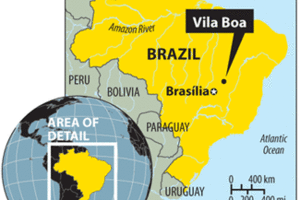Mayor in Brazil transforms 'deadliest' town
It has fallen from sixth to 298th on the country's Violence Map.

scott wallace -staff
Vila Boa, Brazil
When he took office in 2004, Mayor Waldir Gualberto de Brito knew swift action was needed to bury the town's reputation as the most violent place in Brazil.
The Violence Map, a periodic state-sponsored study, named Vila Boa the sixth-deadliest town in the country from 2002 to 2004.
Over the next three years, it fell to 298th.
Walking around this sleepy town of 4,300 people today, it is hard to imagine that anything dangerous happens here. Goats and horses walk the streets; bicycles outnumber cars.
Crime has fallen across Brazil in recent years, thanks to an improved economy, tougher police presence, and restrictions on guns and alcohol.
While these factors have helped Vila Boa – which is 100 miles northeast of Brasília, the capital – many also attribute the town's drastic transformation to Mayor de Brito's efforts to tackle the causes of violence, rather than violence itself.
"The priority was making people's lives better," de Brito says. "I knew that if we improved the quality of life, then we'd reduce crime."
De Brito, who has showered the town with public works programs and social services, says his first aim was to implement public policies designed to "help raise self esteem and give people hope."
"I think public administrators need to address the problems that lead people into crime," he adds.
Under his tenure, the town has installed a new drainage system to stop recurring floods, opened a second health clinic, and paved almost three miles of streets, raising the area of paved roads to 90 percent from 65 percent.
It built and delivered 80 low-cost houses to the poorest families and opened a community center with Internet access. A public plaza with recreational facilities is taking shape in the town center, while on the outskirts, laborers are building a new soccer field – the town's first to have bleachers.
Government-paid tutors are giving lessons to those wishing to earn a living as seamstresses, cheesemakers, artisans, or bakers. Kids can attend after-school soccer training and take citizenship classes taught by the police.
Residents say the town feels different and safer as a consequence.
Outside help
De Brito recognizes that his efforts aren't the only force behind the changes in town, which between 2005 and 2007 saw only one homicide, compared with 11 in the three years preceding.
External factors have helped greatly. Many of the town's poorest families get a regular income through the Bolsa Família, a federal aid program that pays parents to keep their children in school.
The mayor's affiliation with the Workers' Party of President Luiz Inacio Lula da Silva may have helped secure federal funds for his public works programs, something de Brito himself acknowledges.
And the opening of a sugar cane factory nearby has provided hundreds of jobs and injected much-needed cash into the local economy.
More police, fewer weapons
In Vila Boa and other parts of Brazil, a greater police presence and restrictions on guns and alcohol have also helped reduce crime, experts agree.
As one indicator, the deadliest spot on the 2006 Violence Map – Coloniza, an Amazonian back-water – had a homicide rate of 164 per 100,000; last year's leader, Coronel Sapucaia, had just 107 per 100,000.
Brazil passed a law in 2003 greatly restricting weapons sales and, though a more permanent law was rejected by voters two years later, that legislation got many guns off the streets, says Julita Lemgruber, director of the Security and Citizenship Study Center in Rio de Janeiro.
The police have also become more visible. In Vila Boa, the number of officers has risen from eight in 2005 to 12 today, and they have been given additional vehicles with which to operate.
Their job has been made significantly easier by a local law banning the sale of alcohol after midnight on weekdays. Ms. Lemgruber says similar legislation has been passed in other municipalities, especially in São Paulo, the country's biggest and most populous state.
"I'd estimate that 80 percent of all crime [here] involves alcohol," says Lt. Edir Guimaraes Sobrinho, Vila Boa's police chief. "I think closing bars and stopping people drinking into the wee hours, and putting more police on the streets – that benefits people. That is the big advance."
That move to more conspicuous policing is also being hailed as a success in big cities.
In Rio de Janeiro, the homicide rate has fallen from 46.1 per 100,000 in 2002 to 39.5 per 100,000 in 2006, according to police figures, which tend to be more conservative.
In Recife, Brazil's most violent major city, the rate has fallen from a high of 58.9 per 100,000 in 2001 to 53.9 per 100,000 last year, police say.
And in the state of São Paulo, the number of homicides has dropped from 12,800 in 1999 to 4,800 in 2007.
Officials there compare the improvement to the remarkable turnarounds witnessed in New York and in Bogotá, Colombia, two cities that drastically reduced their crime rates with crusading mayors and more intelligent policing.
"Our rate of reduction has been even more marked," said Tulio Kahn, coordinator of analysis and planning with the state police, at a press conference last month. "Those are cities. This is a state. We've seen a fall in 538 of the [state's] 645 municipalities. The reduction is widespread. And in the capital the decrease is even greater, 72 percent."
Experts caution that it's too soon to say if the drop in crime will continue. Brazil still has 14 million unlicensed weapons, according to government figures.
Current trends have nonetheless been refreshing. "For the first time in Brazilian history, we have had three years in which the measures of fatal violence have fallen," says Julio Jacobo Waiselfisz, author of the Violence Map. "There is light at the end of the tunnel."
